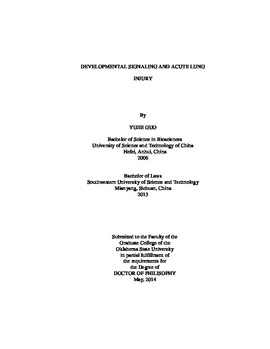| dc.contributor.advisor | Liu, Lin | |
| dc.contributor.author | Guo, Yujie | |
| dc.date.accessioned | 2015-06-17T20:06:05Z | |
| dc.date.available | 2015-06-17T20:06:05Z | |
| dc.date.issued | 2014-05 | |
| dc.identifier.uri | https://hdl.handle.net/11244/14862 | |
| dc.description.abstract | The present study is initiated to explore the potential implication of developmental signaling in AEC I injury, acute inflammatory response, and host defense against pathogen invasion during the pathogenesis of ALI/ARDS. | |
| dc.description.abstract | We demonstrated that P2X7R induced AEC I death by suppressing Wnt/B-catenin signaling through activating GSK-3B and proteasome. On the other hand, Wn3a overrides the effect of P2X7R on inhibiting Wnt/B-catenin signaling to prevent the AEC I death and restricts the severity of ALI/ARDS. Our study on Wnt/B-catenin signaling and P2X7R-mediated purinergic signaling provides insights for future drug development and new therapeutic strategies to limit AEC I damage in ALI/ARDS patients. | |
| dc.description.abstract | Furthermore, we identified platelet-derived Dkk1 as the major Wnt antagonist, contributing to the depression of Wnt/B-catenin signaling during ALI/ARDS. Intratracheal administration of Wnt3a or neutralization of Dkk1 inhibited neutrophil influx into alveolar airspace of the injured lungs potentially through the attenuated ICAM-1/VCAM-1 mediated adhesion of inflammatory cells. We reported for the first time a role of Wnt/B-catenin signaling in modulating inflammatory response, and a functional communication between platelets and AEC during ALI/ARDS. Targeting Wnt/B-catenin signaling and this communication therefore represents a potential therapeutic strategy to reduce acute inflammation in ALI/ARDS patients. | |
| dc.description.abstract | Lastly, we discovered that Axin1, a scaffold protein, was degraded during influenza virus infection of mice. More importantly, we found that Axin1 boosted type I IFN response to influenza virus infection through the stimulation of JNK/c-Jun and Smad3 signaling. Axin1 also interacted with IFIT1/2/3, a viral RNA sensor complex. In addition, Axin1 specifically promoted the degradation of hnRNP M, a nucleoprotein required for efficient activity of influenza virus polymerases, and sequentially EZH2. Axin1 and its chemical stabilizer, XAV939, successfully reduced influenza virus and respiratory syncytial virus replication, and protected the mice from influenza virus infection. Thus, our study provides new mechanistic insights into the regulation of type I IFN response and presents a new potential therapeutics of targeting Axin1 against influenza virus infection and reducing the incidence of viral pneumonia. | |
| dc.format | application/pdf | |
| dc.language | en_US | |
| dc.rights | Copyright is held by the author who has granted the Oklahoma State University Library the non-exclusive right to share this material in its institutional repository. Contact Digital Library Services at lib-dls@okstate.edu or 405-744-9161 for the permission policy on the use, reproduction or distribution of this material. | |
| dc.title | Developmental signaling and acute lung injury | |
| dc.contributor.committeeMember | Hadwiger, Jeff | |
| dc.contributor.committeeMember | Hinsdale, Myron | |
| dc.contributor.committeeMember | Malayer, Jerry | |
| dc.contributor.committeeMember | Oomens, Tom | |
| osu.filename | Guo_okstate_0664D_13270.pdf | |
| osu.accesstype | Open Access | |
| dc.type.genre | Dissertation | |
| dc.type.material | Text | |
| dc.subject.keywords | acute lung injury | |
| dc.subject.keywords | cell death | |
| dc.subject.keywords | host defense | |
| dc.subject.keywords | inflammation | |
| dc.subject.keywords | wnt/beta-catenin | |
| thesis.degree.discipline | Veterinary Biomedical Sciences | |
| thesis.degree.grantor | Oklahoma State University | |
